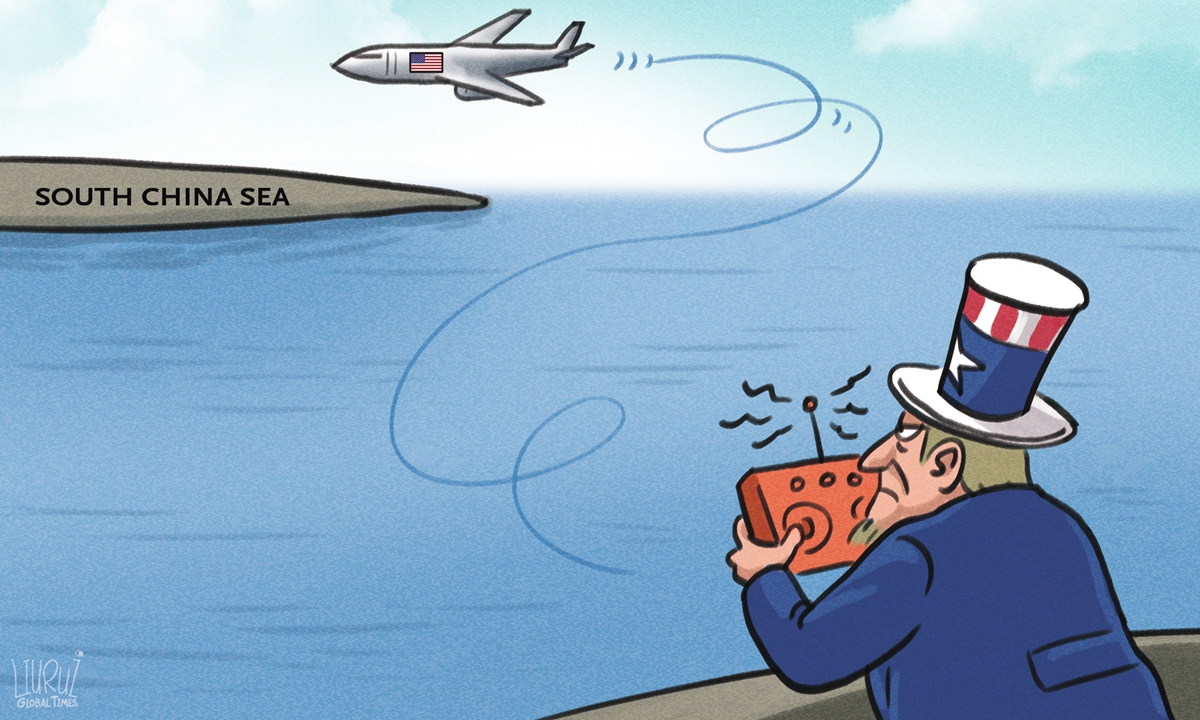How to defuse South China Sea tensions?
By He Yafei Source: Global Times Published: 2020/10/21 15:28:32

Illustration: Liu Rui/GT
South China Sea seems to be a flash point for possible conflicts between China and the US. It will be a testing ground for the future of China-US geopolitical ties. Will it be a strategic rivalry, a competition within a rules-based framework, or cooperation? What are the possible signs now? Military competition has become increasingly tense between China and the US. And it's very likely to involve the South China Sea.
US Congressional Research Service argued in February 2020 that general potential US goals for US-China strategic competition in the South China Sea may include fulfilling US security commitments in the Western Pacific, including treaty commitments to the Philippines and so on; maintaining and enhancing the US-led security architecture in the Western Pacific; maintaining a regional balance of power favorable to the US and its allies and partners; defending the principle of peaceful resolution of disputes; preventing China from becoming a regional "hegemon."
This is quite official.
China and the US have different definitions of concepts, such as offense or defense, regarding China's construction on islands and reefs, and the "militarization" of the South China Sea. Moreover, the shift in the balance of power between the two and a subsequent misperception of the other's intentions are driving those differences to extremes.
The US, I believe, wrongly perceives China's actions in the South China Sea as posing threats to its strategic interests. China senses that US' actions, claimed or actually done, are provocative and dangerous.
Against this backdrop, US President Donald Trump's administration has planned more robust measures to curb China's growing influence in the South China Sea. Unilateral actions by some claimants are a factor of instability in the South China Sea. A small number of countries may push ahead with oil and gas exploration activities in blocs which they have claimed.
The second reading of the ASEAN-China Single Draft Code of Conduct in the South China Sea Negotiating Text has started. But differences have emerged among claimants over various issues, including who and what the code of conduct should regulate, whether or to what extent it should be legally binding, and so on. Legal disputes over the South China Sea islands have also become intensified.
What steps should be taken? How should we manage the South China Sea and its related issues? As Robert Kaplan, president of the Federal Reserve Bank of Dallas, said, the US, not China, might be the problem in the future. Since the US brought the South China Sea affairs into the great power competition and strategic rivalry from 2010 onward, it is uncertain if efforts by China and ASEAN countries to build a rules-based framework in the South China Sea through code of conduct negotiations will succeed. The US, in this case, has played the role of a peace breaker rather than a peace builder. So we do hope the first step is for the US to reverse its role.
Honestly, peace in the South China Sea serves the best interests of China, the US and ASEAN members. China and the US have been working to build consensus and a crisis management mechanism to avoid direct conflict. This is quite urgent now. We need actionable crisis management mechanisms.
However, as mounting US military exercises and activities keep tensions with China high in the South China Sea, rules of behavior for the safety of the air and maritime encounters by the two need to be workable. It will be a test.
The absence of security cooperation mechanisms is the main pitfall for security challenges in the region. Mechanisms such as ASEAN+1, ASEAN+3, ASEAN Regional Forum are, to my eyes, inadequate for that purpose. So it is necessary for countries in the South China Sea to formulate legally binding and operational rules for security at sea in order to increase the political costs for parties which violate the rules.
Issues to be addressed regarding security cooperation mechanisms in the South China Sea should include conflicts of sovereignty and security interests among claimants, maritime conflicts triggered by conflicts or crisis, the growing interests and aspirations of extraterritorial powers - with the US in particular. How can we manage that? Long-term mechanisms for crisis prevention should also be put in place. Regional peace and stability represent the best security interest for everyone involved in the South China Sea. Littoral countries of the South China Sea, including Thailand, Singapore, and Indonesia, are keen to maintain regional stability. This needs, of course, a cooperative relationship with China.
It is unrealistic to believe that resolutions for the disputes over the South China Sea could be reached in the short term. Whatever solutions we offer now, the parties concerned differ considerably in their approaches of resolving disputes. They carry a deep mutual distrust.
So, overall cooperation would help build a mutual trust for collaborative resolutions. More importantly, bilateral and multilateral communication and liaison mechanisms, including emergency hot lines, the security code of conduct, and the rules of engagement, will help better manage possible conflicts that seem to loom on the horizon.
The author is former vice foreign minister of China. The article is an excerpt of his speech during 2020 US-China Dialogue, held by US-based Just World Educational and Chongyang Institute for Financial Studies, Renmin University of China. opinion@globaltimes.com.cn
Posted in: VIEWPOINT